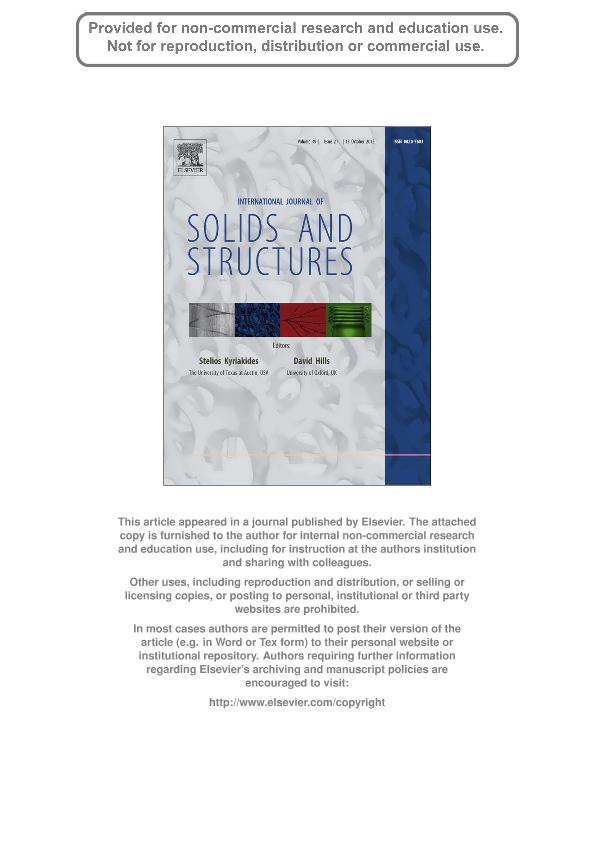Mostrar el registro sencillo del ítem
dc.contributor.author
Oliver, J.
dc.contributor.author
Mora, D. F.
dc.contributor.author
Huespe, Alfredo Edmundo

dc.contributor.author
Weyler, R.
dc.date.available
2017-06-23T19:16:51Z
dc.date.issued
2012-07
dc.identifier.citation
Oliver, J.; Mora, D. F.; Huespe, Alfredo Edmundo; Weyler, R.; A micromorphic model for steel fiber reinforced concrete; Elsevier; International Journal Of Solids And Structures; 49; 21; 7-2012; 2990-3007
dc.identifier.issn
0020-7683
dc.identifier.uri
http://hdl.handle.net/11336/18784
dc.description.abstract
A new formulation to model the mechanical behavior of high performance fiber reinforced cement composites with arbitrarily oriented short fibers is presented. The formulation can be considered as a two scale approach, in which the macroscopic model, at the structural level, takes into account the mesostructural phenomenon associated with the fiber–matrix interface bond/slip process. This phenomenon is contemplated by including, in the macroscopic description, a micromorphic field representing the relative fiber–cement displacement. Then, the theoretical framework, from which the governing equations of the problem are derived, can be assimilated to a specific case of the material multifield theory. The balance equation derived for this model, connecting the micro stresses with the micromorphic forces, has a physical meaning related with the fiber–matrix bond slip mechanism. Differently to previous procedures in the literature, addressed to model fiber reinforced composites, where this equation has been added as an additional independent ingredient of the methodology, in the present approach it arises as a natural result derived from the multifield theory. Every component of the composite is defined with a specific free energy and constitutive relation. The mixture theory is adopted to define the overall free energy of the composite, which is assumed to be homogeneously constituted, in the sense that every infinitesimal volume is occupied by all the components in a proportion given by the corresponding volume fraction. The numerical model is assessed by means of a selected set of experiments that prove the viability of the present approach.
dc.format
application/pdf
dc.language.iso
eng
dc.publisher
Elsevier

dc.rights
info:eu-repo/semantics/openAccess
dc.rights.uri
https://creativecommons.org/licenses/by-nc-sa/2.5/ar/
dc.subject
High Performance Fiber Reinforced Concrete (Hpfrc)
dc.subject
Failure of Hpfrc
dc.subject
Short Reinforcement Fibers
dc.subject.classification
Ingeniería Civil

dc.subject.classification
Ingeniería Civil

dc.subject.classification
INGENIERÍAS Y TECNOLOGÍAS

dc.title
A micromorphic model for steel fiber reinforced concrete
dc.type
info:eu-repo/semantics/article
dc.type
info:ar-repo/semantics/artículo
dc.type
info:eu-repo/semantics/publishedVersion
dc.date.updated
2017-06-21T18:38:34Z
dc.journal.volume
49
dc.journal.number
21
dc.journal.pagination
2990-3007
dc.journal.pais
Países Bajos

dc.journal.ciudad
Amsterdam
dc.description.fil
Fil: Oliver, J.. Universidad Politecnica de Catalunya; España
dc.description.fil
Fil: Mora, D. F.. Universidad Politecnica de Catalunya; España
dc.description.fil
Fil: Huespe, Alfredo Edmundo. Consejo Nacional de Investigaciones Científicas y Técnicas. Centro Científico Tecnológico Conicet - Santa Fe. Instituto de Desarrollo Tecnológico para la Industria Química. Universidad Nacional del Litoral. Instituto de Desarrollo Tecnológico para la Industria Química; Argentina
dc.description.fil
Fil: Weyler, R.. Universidad Politecnica de Catalunya; España
dc.journal.title
International Journal Of Solids And Structures

dc.relation.alternativeid
info:eu-repo/semantics/altIdentifier/doi/http://dx.doi.org/10.1016/j.ijsolstr.2012.05.032
dc.relation.alternativeid
info:eu-repo/semantics/altIdentifier/url/http://www.sciencedirect.com/science/article/pii/S0020768312002429?via%3Dihub
Archivos asociados
